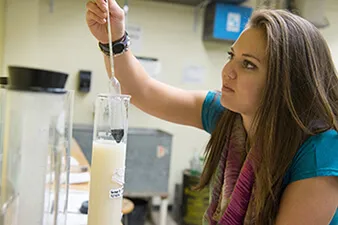UVM’s BME program is now one of a handful of accredited BME programs co-located on the same campus as a medical school. UVM’s program and the Larner College of Medicine (LCOM) are a quarter mile apart and some of the faculty in Biomedical Engineering have labs in LCOM. ABET (Accreditation Board for Engineering and Technology) recognized this valuable asset in its evaluation, in particular noting the unique opportunities that UVM students have had for coursework, design projects, internships, and research experiences in collaboration with the medical school faculty.
According to Dean Linda Schadler, the ABET accreditation affirms the BME program’s excellence and vitality. “Not only did we receive accreditation, we have created a unique curriculum with an outstanding design sequence, access to the Center for Biomedical Innovation, and opportunities for entrepreneurship, as well as medical school experiences. I am thrilled to see the program reach this mature status,” Schadler says.
Students are also proud to be part of this program. Recent graduate Lara Weed noted, “As a direct result of UVM BME and my experiences in the program, I was selected for a highly competitive year-long co-op at MIT Lincoln Laboratory, a summer internship at Merck, and a Bioengineering PhD program at Stanford University.” Weed says, “The ability to walk from the engineering building to the medical school and hospital made getting involved with real research and engineering as an undergrad incredibly accessible. This in an invaluable opportunity that distinguishes UVM from other programs.”
Rising and Shining
Started in 2016, the BME program has already grown to be UVM’s second largest engineering program. Its students have graduated to join companies like Medtronic and GE Health Care or have gone on to pursue graduate degrees at schools such as Duke, UCLA, and Stanford. While at UVM, students have conducted research with the BME faculty in engineering and medical researchers in the Larner College of Medicine. Several have held internships at UVM’s Instrumentation and Modeling Facility where they have designed and fabricated custom instrumentation for researchers.
With accreditation, UVM is doubling down on its investment in BME. The program has recently hired an expert in neuroengineering and brain-computer interfaces to join its faculty and is introducing a new project- and design-intensive curriculum. This new curriculum takes advantage of the Center for Biomedical Innovation (CBI), a partnership between CEMS, LCOM, the College of Nursing and Health Sciences (CNHS), and the Grossman School of Business (GSB), to develop new technologies and devices that improve the delivery of high-quality health and wellness care.
From Concept to Communities
CBI is a design studio that opens its doors to design projects for students starting in their first year. When innovations in CEMS, LCOM, and CNHS have been prototyped, commercialization efforts are supported by entrepreneurship faculty from GSB. Example CBI projects include the “Vermontilator” – a low cost emergency use ventilator – and PanicMechanic – an app to manage panic attacks, and a new virtual reality interface for children undergoing surgery. These projects have been covered by The New Yorker and CBS News and are already helping to improve human health across the world.
Through the curriculum, BME students have opportunities to solve real biomedical engineering problems starting in their first year. These projects help students develop the skills and experience needed to apply engineering principles to improving human health and making a positive impact on humankind.
